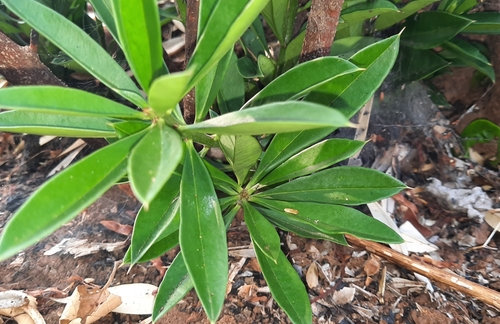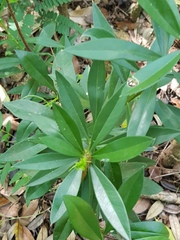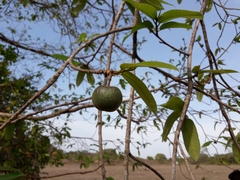

|
|
|
|
Family: Theophrastaceae
Cudjoewood, more... (es: barbasco, Tuliviejo)
[Jacquinia macrocarpa] |
Descripción: Árbol o arbusto de 2 a 8 m de alto. Tronco con la corteza exterior gris o negra. Hojas simples y alternas, de 5-10 x 1.5-3 cm, elípticas a obovadas, con ápice agudo, bordes enteros y base aguda a obtusa. Las hojas son coriáceas y el ápice termina en una espina aguda. Flores rojas o anaranjadas. Frutos globosos, de 3-4 cm de largo, verdes, tornándose amarillos o anaranjados al madurar. Datos Ecológicos: La especie crece a bajas elevaciones, en lugares y áreas secas cercanas a la costa. En Panamá se encuentra en las provincias de Coclé, Herrera, Los Santos y Panamá. Común y fácil de observar en los terrenos del Parque Nacional Sarigua. Florece y fructifica entre noviembre y abril. Especies Parecidas: La especie es inconfundible y se caracteriza por sus hojas coriáceas con una espina aguda en la punta. Usos: En el pasado los arbolitos pequeños y más coposos eran despojados de sus hojas y se utilizaban como arbolitos de navidad. Las raíces, las hojas y los frutos macerados en agua, se emplean como barbasco con la finalidad de embriagar o narcotizar a los peces para poder atraparlos. Small tree. Leaves very stiff, elliptic to obovate, acute to rounded at apex with a sharp apiculum, acute at base, 6-10 cm long, 2-3.5 cm wide, +/- sessile, glabrous except on upper midrib. Racemes corymbiform; flowers pleasantly and strongly aromatic; sepals coriaceous, persisting in fruit, the lobes rounded, imbricate, the margins thin; corolla bright orange, coriaceous, the lobes 5, blunt, alternating with 5 petaloid staminodia; stamens 5, extrorse, held closely together around the style (the pollen may be shed in bud), after several days folding back against tube to expose the much shorter stigma; ovary unilocular; ovules many, on a stalked basal placenta; stigma capitate, covered with a viscid liquid. Fruits oblong-elliptic, apiculate, to 7 cm long, yellowish; exocarp thick, woody; seeds several, dark brown, hard, shiny. Croat 12885. Cultivated at the Laboratory Clearing. Flowers sporadically throughout the year, mostly in the dry season and the early rainy season. The species is not deciduous on BCI (R. Foster, pers. comm.). In Costa Rica, plants lose their leaves within 8 weeks of the first rains and are usually completely leafless by the first week of July, remaining leafless through the rest of the rainy season until late November or December. Flower buds are present within 1 month after new leaf production, and nearly all flowers are open within 2 months. The fruits begin to mature in the middle of the rainy season. The species has been called J. aurantiaca Ait. inPanama; it is not known for certain that J. aurantiaca is synonymous with J. macrocarpa. |


























